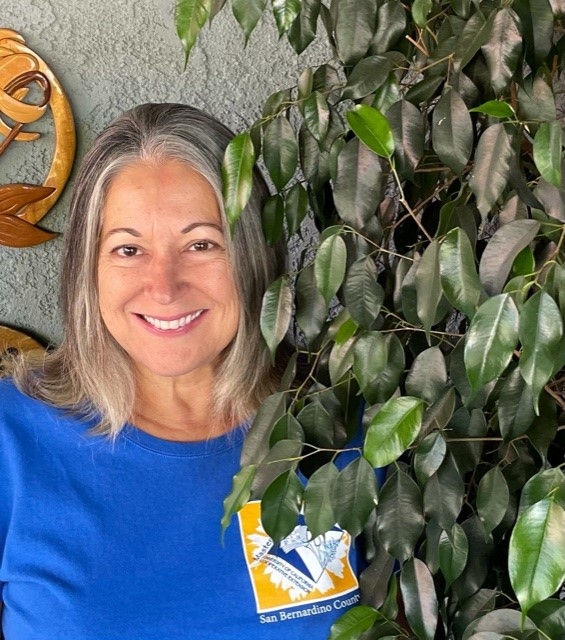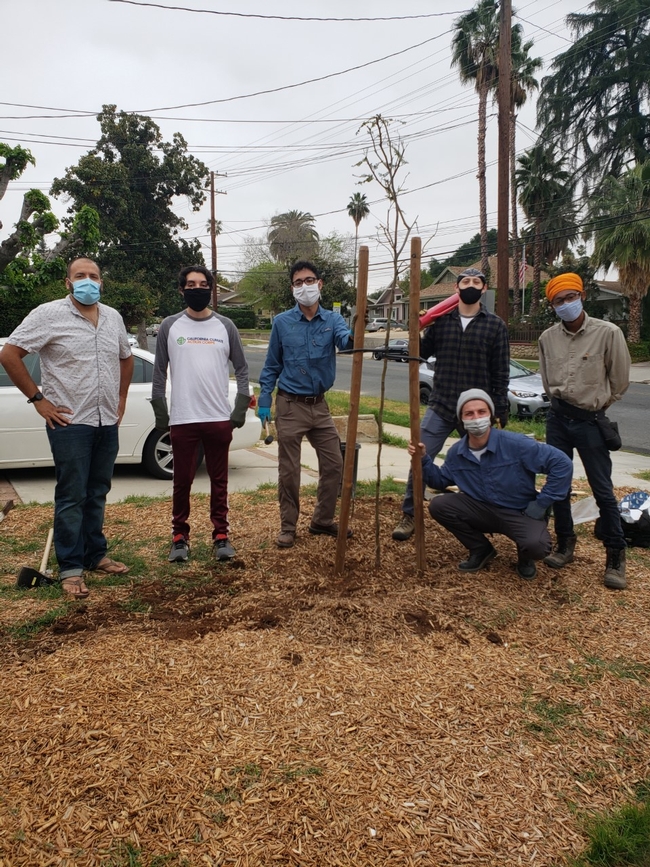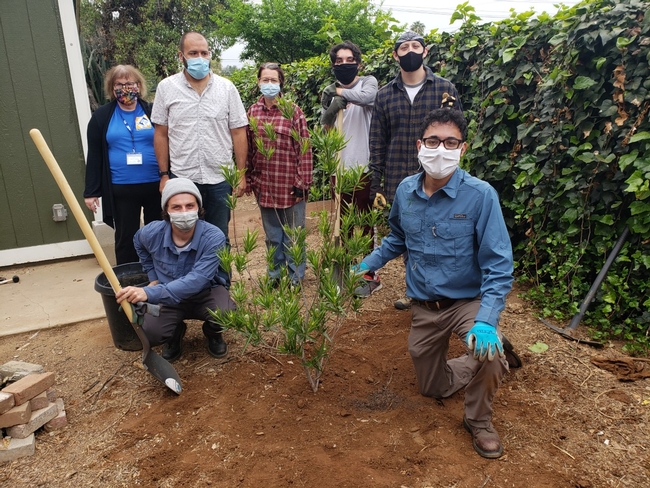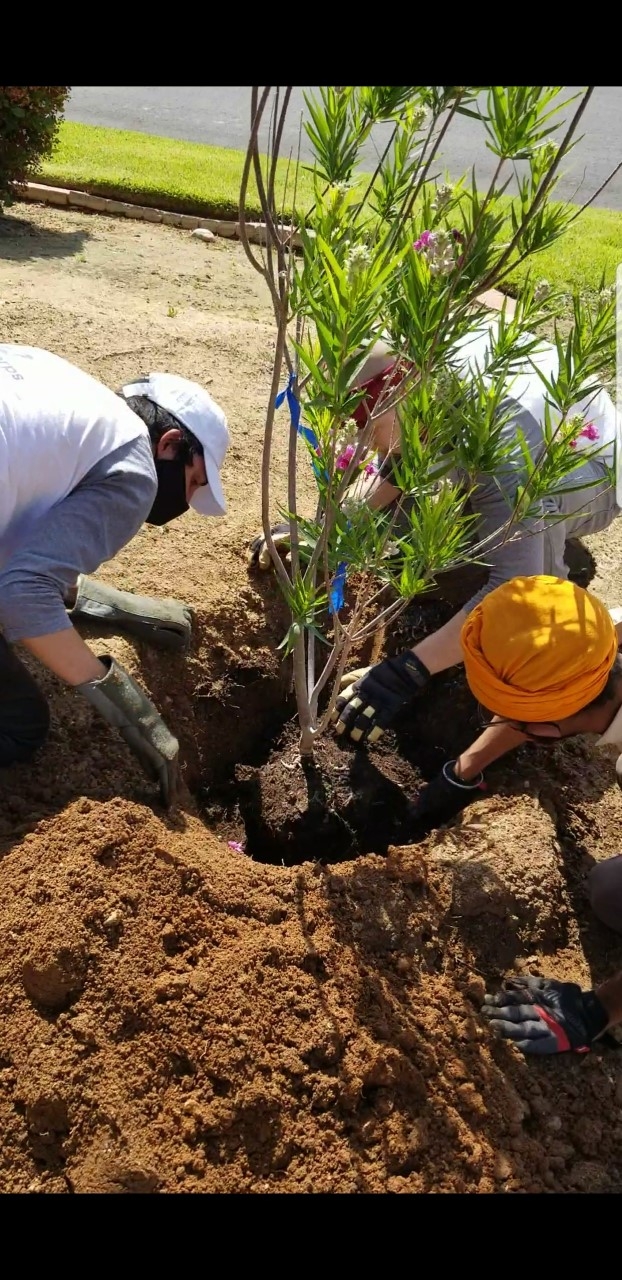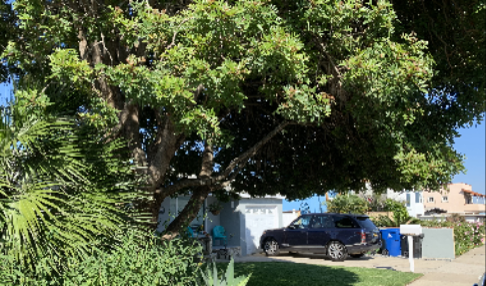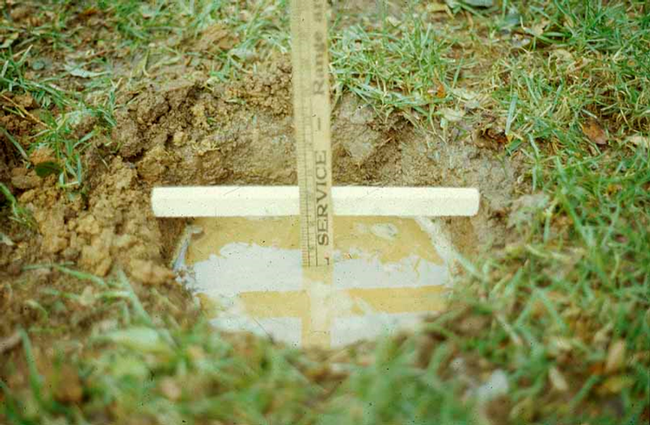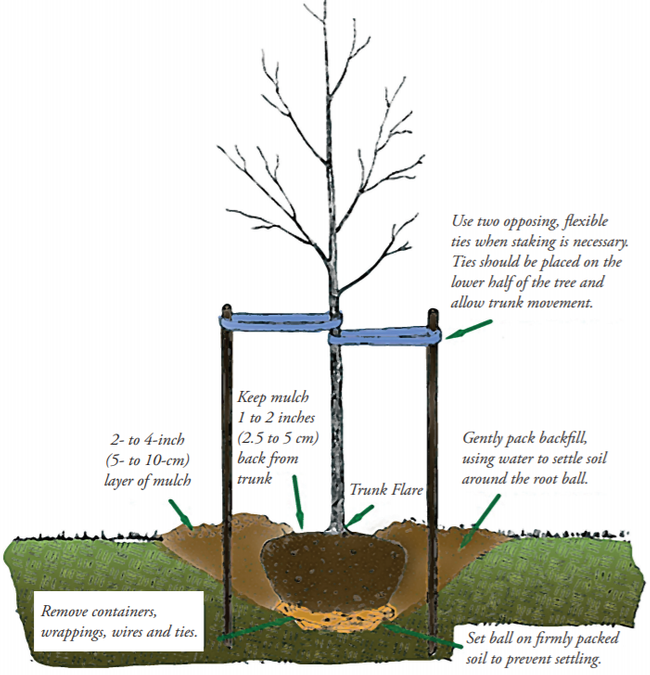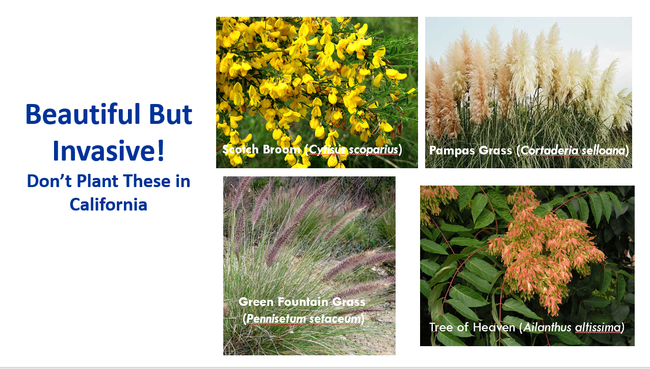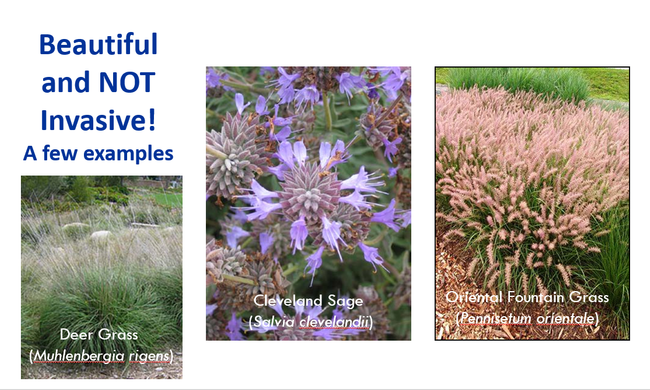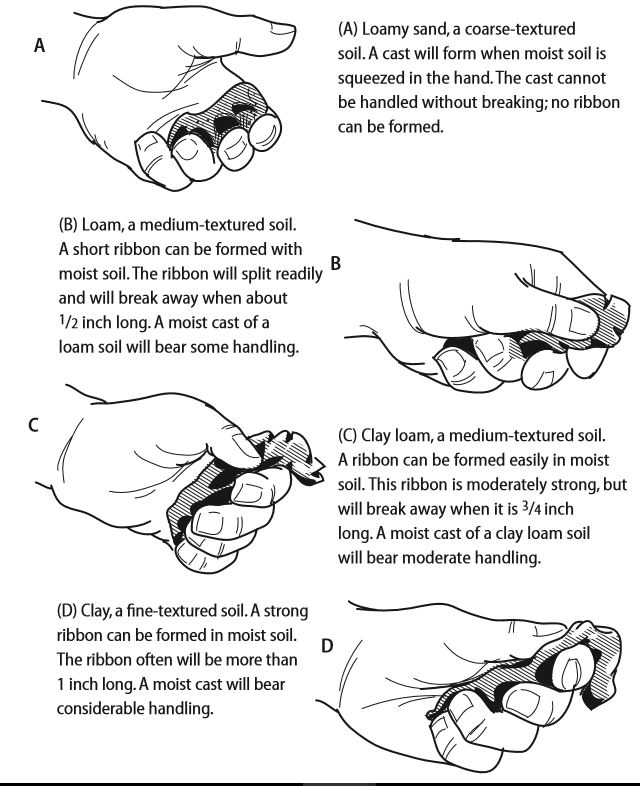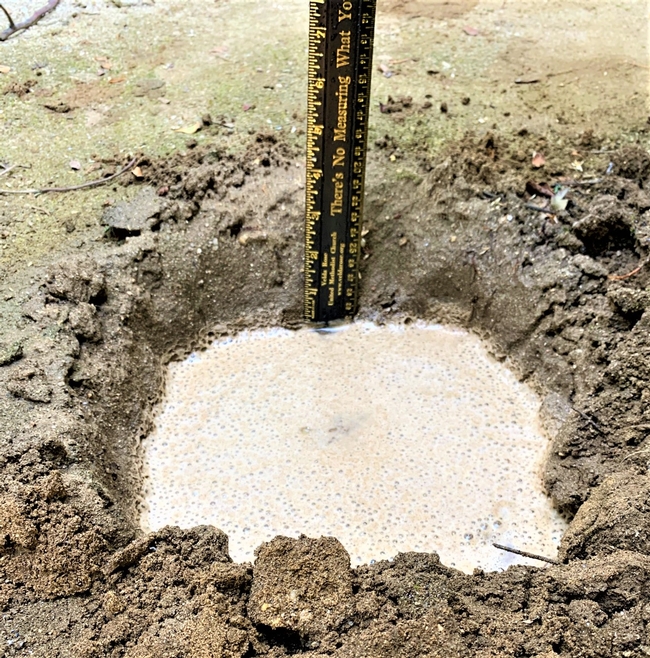Posts Tagged: tree
Master Gardener Spotlight: Redlands Tree Canopy Enhancement Team
It's only right that our University of California Cooperative Extension (UCCE) San Bernardino County Master Gardener ‘Trees for Tomorrow' team of volunteers are our featured ‘Spotlight' Master Gardener volunteers for September, 2021. They provided vital education to Redlands residents receiving gratis trees through a multi-partnership grant obtained by Inland Empire Resource Conservation District Manager Mandy Parkes.
It's an honor and privilege to recognize UCCE San Bernardino County Master Gardener Project Leader Debbie LeDoux and her dedicated team of 'Trees for Tomorrow' volunteers: Zhibo (Sandy) Anderson; Consuelo (Connie) Davis (pictured); Pam O'Connell; Gail Sefl; and Husam Yousef. These dedicated Master Gardeners were tasked with helping residents select, plant and care for drought, heat, and pest tolerant trees. (Species including Chilopsis linearis 'Bubba', and Pistacia x 'Red Push' were selected due to their excellent performance in our University of California/United States Forest Service research project as 'climate-ready' trees able to withstand harsh conditions related to our changing climate.) Working with a team of California Climate Action Corps volunteers, civic leaders, Common Vision Coalition, and other groups, nearly 100 trees were planted in yards and parks lacking the preferred 25% tree canopy cover.
Trees can cool urban heat islands by 50 degrees Fahrenheit or more during spring and summer, creating welcome oases in hot inland communities. With spring 2021 temperatures so high they broke previous records on multiple dates, the project is especially timely and necessary.
In addition to proper tree selection, trees require the right long-term care. Master Gardeners will continue to provide advice on irrigation, pruning, fertilizing and pest control to residents receiving trees long after the trees are planted. This is critical since an average urban tree lives less than 20% of its potential lifespan due largely to poor care. The long-term engagement of Master Gardeners with residents is as important as is selecting the right species.
UCCE Master Gardeners are all volunteers, giving of their time and talents to enhance the quality of life for individuals and families who call San Bernardino County their home. Each Master Gardener is required to complete a rigorous 18-week training class complete with exams, class projects, and lots of participation! Due to COVID-19, volunteers had to master key horticultural concepts during the first ever all on-line training class. Only recently have they been able to meet fellow Master Gardener graduates and, in some cases, the Redlands residents they mentored through the tree canopy enhancement project. They truly exemplify community spirit and all it takes to successfully work together under adverse conditions. Kudos to each and every one of you from Master Gardener Coordinator Maggie O'Neil and myself! You are creating a cooler, greener and healthier environment for our children's children.
I asked the honored Master Gardeners their thoughts on the project. Here's what they had to say:
“The Redlands tree canopy project was the best volunteer project ever. In the midst of Covid-19, horrific politics and way too many good byes, it was a truly joyous experience. The legacy of being a part of the group that promoted healthy sustainable trees, knowledge of how to plant and care for them, tips on maintaining their health and beauty was the absolute best. For me as a Master Gardener, it was so much fun. I loved the site walks and getting to help our participants select the perfect sustainable trees for their properties. What started as a one-on-one visit often expanded to an enlarged group of neighbors and extended family. I got to give out many handouts and publications and promote our excellent Master Gardener program. I got to share our helpline email and phone numbers. I love the fact that I have been asked to revisit sites to see how great they are doing (once to make sure the tree did not look funny!). I receive emails every now and then asking me questions and showing me pictures of "Our Trees.” So much fun, Janet. Thank you. By far the coolest project ever! Pam O'Connell
------------------------------------------------------------------------------------------------------------------
There are a few things that really made an impact on me.1) It was rewarding to attend the Zoom presentation you developed that provided education to various professionals on the importance of planting sustainable trees. I found it to be open and inclusive allowing for good interchange of ideas and concerns.2) There are many beautiful trees that are sustainable.3) Reaching out to the community to offer beautiful, sustainable trees was a worthwhile way to show how various organizations can work together to benefit the community while trying to improve our environment.4) When dealing with homeowners that belong to an HOA, additional time and communication may be needed to assist them in obtaining approval for trees from their HOA's. Connie Davis
-----------------------------------------------------------------------------------------------------------------
"I see tree planting efforts similar to what a trend of the future is to combat climate change and increase awareness of the importance of trees and tree canopies in our neighborhoods. Not only that but I see this project expanded to other cities in the county of San Bernardino. The continuity of this project is so valuable so that we can see the positive impact on the environment and the well-being of San Bernardino residents in the coming decades. I see this important work being organized and well-coordinated by involving the appropriate stakeholders at all stages of the planning project. It is about time to give back what we have taken for tens of years!" Husam Yousef
------------------------------------------------
It was rewarding to see local homeowners excited about planting trees and grateful for the program providing them. Gail Sefl
---------------------------------------------
THANK YOU ALL! Janet Hartin and Maggie O'Neill
Plant a Tree. Leave a Legacy!
Do you have Spring Fever? If you have adequate space, why not leave a legacy to your children's children by planting a tree? When the right species is planted in the right location with the right care, landscape trees can be enjoyed for 100 years or more. Landscape trees cool urban heat islands, absorb carbon dioxide, filter toxic chemicals from soil preventing them from polluting our waterways, reduce soil and water erosion, reduce internal energy needs and related costs, provide habitat, and beautify neighborhoods.
Spring is a much better times to plant a container landscape tree in California than is summer. Trees incur far less stress if they've been in the ground several weeks rather than having to immediately adapt to high summer temperatures. Cooler weather allows plants to establish roots in their new ‘home' before the harshness of summer sets in. (Deciduous bare-root fruit trees, on the other hand, should be planted during the winter when they are dormant.) Choose recommended species for your climate and micro-climate.
Choose trees based on your Sunset climate zone (more precise than USDA zones for California since they include impacts of high temperatures as well as low temperatures) and your microclimate (shade, soil conditions, space, etc.). Four of my favorite search engines that allow one to search by multiple criteria (size, water needs, flower color, ecosystem functions, pest susceptibility, etc.) are: Inland Valley Garden Planner: https://inlandvalleygardenplanner.org/; Cal Poly, Pomona: https://selectree.calpoly.edu;California Native Plant Society: http://www.cnps.org/cnps/grownative/lists.php; and WUCOLS IV (Water Use Classification of Landscape Species): http://ucanr.edu/sites/WUCOLS
Avoid circled, girdled roots. Remember to inspect the root system of container trees. Avoid purchasing specimens with severely circled and girdled roots. Root pruning will not solve the problem and the resulting tree is much more prone to failure later. This occurs because the upper portion of the tree continues to grow and expand while the root system lacks the breadth and architectural strength to support the tree. Many times a tree will look fine for several years and - seemingly - very suddenly topple in winds that otherwise it could sustain with a more adequate root system. Only when the tree falls does the owner actually notice firsthand that the root system is the same size it was when the tree was planted years before!
Check drainage before you plant. Dig a hole where you are planning on planting the tree, fill it with water, and make sure it completely drains within 24-hours. If it doesn't drain, don't plant a tree there. In some cases, trees are carefully selected based on species and location only to perish ten or more years later due to poor drainage and water-logged soil. Trees often die in these situations due to a lack of aeration setting them up for disease-causing fungal pathogens.
Planting the tree. Dig a hole at least 2-1/2 times the width of the container (in clay or compacted soils make the hole at least 4-5 times wider) up to two inches shallower than the depth of the tree in the container to compensate for settling. Use a shovel or trowel to roughen the soil on the sides of the hole to encourage root growth into the native soil. Remove the tree from the container along with any loose soil that covers the lower part of the trunk. Carefully place the tree in the planting hole, keeping the trunk flare (the area where the trunk widens and connects with the roots) 1-2 inches above the existing grade. Gently fill the hole with the same soil that was removed. Do not add soil amendments or compost, another common cause of circled and kinked roots. Irrigate the tree immediately after planting through the entire root system and slightly deeper. Keep in mind that soils with appreciable clay content absorb water more slowly than sandier soils and need to be watered longer but less often. Water newly planted container trees often through their establishment period, even if they are drought tolerant species. Recently transplanted trees have a small volume of roots that dry out very quickly. Water newly planted trees regularly through the first season. Trees in sandy soils require more frequent watering than do trees in heavier soils. (After trees are fully established, irrigation frequency should be reduced but more water should be added during each irrigation.)
Avoid staking trees unless necessary. Stake trees only if they were staked at the nursery and/or if they are planted in a wind-prone area. Remember to loosen ties on nursery stock before they girdle the trunk. Gently secure any tree requiring staking with two opposing flexible ties on the lower half of the tree, allowing the tree to gently blow in the wind to encourage lower trunk strength. Avoids taking trees tightly, restricting flex. As the tree matures, remember to loosen ties and aim for removing stakes entirely if the tree is self-supporting.
Pruning. Avoid heavy pruning at the time of planting. Remove only broken branches, crossed branches and suckers at the base of the tree.
Fertilizing. Most trees have received adequate nutrition in the nursery and do not need fertilizer at the time of planting.
Mulching. Apply a 2-4 inch layer of mulch three or more inches away from the tree trunk. Organic mulches such as woodchips and compost should be applied and maintained at a depth of 3-4 inches to prevent weed seeds from sprouting. Inorganic mulches (gravel, pebbles, etc.) should be maintained at 2-3 inches. In fire-prone areas, organic mulches near the urban/forest interface should be avoided. Remember to irrigate below the mulch.
For more information on tree planting and care and all other home gardening and landscape topics, contact the UCCE San Bernardino County Master Gardener Helpline at mgsanbern@ucanr.edu
Invasive Plants: Don't Encourage 'Bad Neighbors'
What do ice cream, potato chips, Scotch and Spanish Broom, and Tree of Heaven have in common? While they're all tempting to indulge in, less is more. In fact, plants such as Scotch, Spanish Broom, Tree of Heaven, Pampas Grass, Green Fountain Grass, and dozens of plants are all considered invasive plants in California. Simply put, they should not be planted. There are some great alternative plants that are better choices listed at the end of this blog.
Truth be told, I admit to falling madly in love with the Spanish Broom (Spartium junceum) shrubs adorning Highway 18 on my drive from San Bernardino to Lake Arrowhead in early spring 1984 right after my job interview for my current position. Being a “wet behind the ears” recently hatched graduate student from the Midwest I was truly in awe of their lovely yellow blooms and vowed to plant one if I got the chance to move to California. Fortunately, I found out very soon that, while the plantings were made on purpose, they were a mistake and needed to be removed due to their invasive nature.
While they were ‘recruited' from Europe and had what seemed like a perfect resumé (fast growth, lovely yellow flowers, adaptability to poor infertile soil and disease and insect-resistance), they didn't play well with others, a fatal flaw. In California, they were aggressive and crowded out native plantings. Fires only exacerbated the situation. After the 2003 burns, the Spanish Broom populations exploded, obliterating any remaining natives and taking an even larger area hostage. In summer 2010, the San Bernardino National Forest removed the plants in a costly but necessary $500,000 project under a partnership with the American Recovery and Reinvestment Act. Constant monitoring continues in the San Bernardino Mountains and other areas of the state to prevent its reestablishment which is challenging due to its ability to quickly resprout, seed longevity, and effective dispersal. It has definitely earned its ‘noxious weed' label!
This is just one example of the problems posed by invasive plants. In effect, they grow too well! They outcompete desirable plants in our gardens, lawns, and other urban and natural areas for water, nutrients, and space. They also shade sun-requiring plants. Threatened and endangered plant species and other California native plants are particularly vulnerable to their encroachment. (In most cases, invasive plants are non-native species.) Interestingly, our beloved state flower, the California poppy, is an invasive plant in New Zealand, Hawaii and other locations outside of California.
As urban gardeners, we can all greatly reduce the impact of the encroachment of invasive plants in our urban environments. Please don't plant invasive sane remove plantings on your property to stop their spread. Below are some great resources to learn more about invasive plants and find viable replacements:
California Invasive Plant Council: https://www.cal-ipc.org/
Don't Plant a Pest: https://www.cal-ipc.org/solutions/prevention/landscaping/dpp/
Invasive Plants of Southern California:https://www.cal-ipc.org/solutions/prevention/landscaping/dpp/?region=socal
PlantRight: https://plantright.org/about-invasive-plants/plant
Landscape Tree Irrigation to Maximize Tree Health, Benefits, and Beauty
Most trees in California need supplemental irrigation above and beyond what Mother Nature supplies naturally. Even drought-resistant species need regular watering through their first growing season due to their shallow roots. Once trees become established, it's important to water less often but more deeply to encourage deep rooting and structural balance above and below ground. Both under and overwatering can lead to unhealthy trees and even death if the situation is not corrected. Trees receiving too little or too much water exhibit similar symptoms since, in both cases, water is not available to the plant. Trees initially wilt, grow slowly, and develop yellow leaves. Over time, growth stops and leaves become brown and drop. Overwatered trees often develop lower crown and root rot from one or more disease-forming pathogens.
Knowing what type of soil you have (soil texture) is as important as knowing the water needs of your trees. Use the ‘feel test' (pictured below) to find out how much water your soil holds and how often to water. Heavier clay-based soils hold water longer and drain more slowly than sandier soils that need to be watered more often for shorter periods of time.
Trees should not be watered on the same irrigation system used for lawns and groundcovers. Soaker hoses and drip systems allow trees to be watered less often but for longer periods of time than your lawn or groundcover. Avoid applying water too close to the trunk. Instead water half-way between the trunk and the dripline of the tree and outward. If you use a garden hose, apply the water on the lowest volume possible slowly, moving the hose every few hours to each of four quadrants around the tree.
Applying a 3-4 inch layer of mulch around the tree can reduce soil evaporation. Use only non-flammable mulches in fire-prone areas within five feet from the house and non-contiguous for the first 30' away from the house. In all cases keep mulch a few inches away from tree trunks to keep the trunks dry.
Tip: Before planting a tree, make sure there is adequate drainage. Dig a hole where you want to plant it (the same depth of the pot, which is about one foot) and fill the hole with water. Let it completely drain and refill it. Measure the time it takes to drain one inch using a ruler. If it does not drain more than one inch an hour it is not a good location for your tree. Avoid adding compost or soil amendments to try to correct the problem since tree roots will likely grow in circles, staying within the confines of the amended hole rather than growing outward the confines of the amended hole rather than growing outward.





